October 31 - November 6, 2021: Issue 516
Ángel R. López-Sánchez
Astrophysicist and Science Communicator
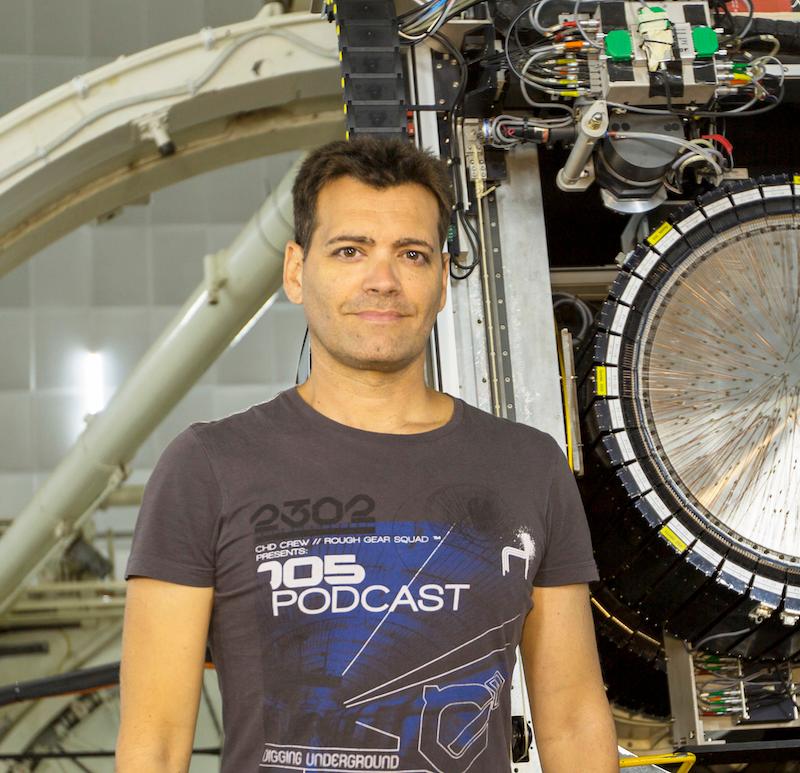
Dr. López-Sánchez is passionate science communicator who continuously gives talks and public lectures, writes popular science articles, podcasts the Skyentists and organises science communication events and stargazing activities.
You can find out more at:
Website: angelrls.wordpress.com
On Twitter: El_Lobo_Rayado
Flickr: www.flickr.com/people/angelrls/
The Skyentists: soundcloud.com/theskyentists
Dr López-Sánchez is a recognised expert in the study of how the gas is converted into stars in nearby galaxies and how this affects galaxy evolution. He leads the "HI KOALA IFS Dwarf galaxy Survey" (Hi-KIDS) program, that uses the instrument KOALA at the 3.9m Anglo-Australian Telescope (AAT) to dissect 80 gas-rich nearby dwarf galaxies to understand their assembly story.
Ángel joined CSIRO's "Astronomy and Space Science" in 2007 to work on the “Local Volume H I Survey” (LVHIS) program, performing radio-interferometric observations of gas-rich galaxies at the Australian Telescope Compact Array. In 2011 he joined the AAO and Macquarie University, combining instrumentation support, research, lecturing, and outreach.
He is a founding member of the Spanish Researcher in Australia-Pacific (SRAP-IEAP) association. He is a globally-recognised science communicator, with visibility in Spanish and Australian printed, broadcast, and social media (one of the Top-100 most-followed astrophysicists in Twitter). His stunning astronomy time-lapse videos have received 1/4 million views in YouTube and have been used by the ABC, BBC, TVE (Spain), US TV channels, and in Science Museums worldwide. He is also a passionate amateur astronomer that uses his own equipment for capturing the beauty of the Cosmos, - some of these images ran as the October 2021 Artist of the Month to celebrate the much needed and run during the recent pandemic safety measures, After Dark Photo Competition: Northern Beaches. This inspired us all to get outstide and look up!
This week a small insight into the work of a resident who has followed their passion to the point where the sky is, literally, no longer the limit.
Where were you born?
In the beautiful city of Córdoba, Spain, a long time ago.
When did you come to Australia?
I moved to Australia in 2007. I had completed my Ph.D. in Astrophysics in the prestigious Instituto de Astrofísica de Canarias (Spain) and University of La Laguna in the Canary Islands in 2006.
I then had the opportunity to come and work for the CSIRO “Astronomy and Space Science” to work on the “Local Volume H I Survey” (LVHIS) program, performing radio-interferometric observations of gas-rich galaxies at the Australian Telescope Compact Array. This was at Narrabri and Parkes.
What was it like being in Parkes?
It was really nice, although I spent more time in Narrabri than in Parkes. It was a real privilege to be there for three years and I had a fantastic time.
What were you doing there?
I was providing help for other astronomers that were coming to use these facilities at the Australian Telescope Compact Array at Narrabri. I was also conducting my own observations for my research.
What is your research area of focus?
My research is about galaxies and galaxy evolution. In particular I am trying to understand how the gas that is in the galaxies condenses and forms stars. The only way to understand that well is by combining radio signals seen through the Australian Telescope Compact Array and now the ASKAP in Western Australia, and using the typical optical observations; the images that we get on our observatory – the typical light that we see for example, through the telescopes at Coonabarabran. This is where I have spent the majority of my time working in the last decade.
In 2011 I joined the Australian Astronomical Optics (AAO) and MQ combining instrumentation support, research, lecturing, and outreach.
How is this progressed and how is it of benefit to us?
There are several aspects of that but there are three main ones. The first thing is increasing our knowledge about galaxies and the universe in general, and helping us to understand how we got here. Because we need all these processes to happen in the universe so that we have galaxies such as the Milky Way, galaxies that have stars similar to our sun, and galaxies that are able to have planets, and planets that may harbour life. We still don’t understand well all the details of these processes.
One of the main things I am study is the chemical evolution of the universe. That is critical for understanding the definition/foundation of life, as this could have only happened after the universe was rich enough in other chemical elements different to hydrogen and helium (the only elements created in the Big Bang). So that is one part of what I work on.
The other part is technology development. Because for getting these kinds of observations and getting these kinds of results, we are pushing the technology a lot. In order to do this work we are creating instruments to put on the telescopes that are able to go deeper and deeper and deeper and get better data.
That is an extremely important aspect because as a by-product of that technology we are able to give that back to society in a very diverse way. For example, everyone is very used to now using Wi-fi; it is everywhere. You probably know that Wi-fi was invented by our Australian astronomers, exactly where I worked when I moved to Australia, in CSIRO. This was a by-product of doing essential research and trying to understand the evolution of supermassive black holes in distant galaxies. At CSIRO they developed the technology for connecting the signal of different radio-telescopes, that evolved into the WLAM, the basis of Wi-fi. That is just one example, but there are many more. Now that I am working at the Australian Astronomical Optics we are world leaders in developing the technology behind optical fibres and multi-fibre instrumentation, that are able to move the light from one point to the other. These techniques have later been used in medicine, in telecommunications and adapted for use in many other aspects of society.
So, although my research is for purely knowing the universe, there is a big part of this that feeds these advances in technology and provides great benefits for society that investing in and having all this kind of research brings.
The third primary aspect of this is provides for everybody and our society to understand better the position of the cosmos. Everyone loves astronomy – everyone wants to know about the stars, about planets, about galaxies and so on. This kind of research is really illuminating. People everywhere, from kids to grownups to seniors, they all really want to know a bit more about the universe.
This is connecting with what I said at the beginning; this is an investigation into how we got here and how we are the way we are. And this shows how precious is the planet we are living in and how important it is to take care of it.
The images you have shared as Artist of the Month; why were these created, apart from being part of celebrating the night sky of the northern beaches?
These were actually those created for family use by my amateur telescope from here – at Frenchs’ Forest. They are not part of my research, although I could use them in this – but I use them in presentations; whether for astronomers, researchers or the general public, or my lectures at the University as they connect very well with the topics I usually try to discuss in these kinds of presentations.
I’m curious about these photographs – in your notes to go with these you stated some took hours to get – why is that, what is the process?
It takes so long because you are observing things that are really really faint. But now technology allows us to capture these details.
When we are looking with our eyes we see something or observe it in 1/50th of a second. We are taking around 50 images in a second, let’s say – possibly less than that. This is the same way we see movies or for the tv; we see a series of images.
In Astronomy we don’t do that; what we are doing is collecting the light over a period of time. We keep our detector open and the light is impregnating the detector or the camera or the film (as we did in the old days), whatever medium you are using. But we don’t do it for hours; we will take, for example, an exposure of half an hour, but then we are taking hundreds of those images – so at the end we will have the equivalent to 50 hours of total observation time! In that way you are going really deep. If you are using special filters you are able to get rid of a good part of the light pollution. That is why I can get deep astronomical images from here at Frenchs Forest thanks of using these filters. Many times we are observing only a very particular colour with these special filters, which is the colour I want to get for containing the gas of a nebula for example. Later we combine 3 final images (each of them using a different filter) to get the final colour image.
The Presentations and Workshops you offer; what topics do you discuss during these?
A lot – a wide range, always depending on who the audience is and what I have been asked to talk about. Although my research is specialised in star formation and galaxies and galaxy evolution, I actually have a very wide range of curiosity and knowledge to share. I can give a talk on the Solar System, and have given many presentations on this for all ages from youngsters to adults, kids love this one. When you speak about the solar system you speak about its size and the distance to the planets, the relationship between the sun and the moon and the earth, and how this affected by the moon phases and so on – and give workshops as well on this.
Talking about cosmology is also a popular theme; this is about talking about the universe on a bigger scale – how the galaxies are distributed, the largest structures of the universe, how the universe came to be, the Big Bang, the evolution of the universe, the dark matter and the dark energy, and so on.
Sometimes I’m asked to talk about astrophotography – sometimes I’m asked to talk about light pollution and how to address that and helping people to understand that we really need to mitigate lighting at night.
I also run a workshop about the Stellar Evolution; how stars are born and how they evolve and how they die – so plenty of subjects I can talk about.
How do people get involved in these workshops?
Usually it is a university or a school or an amateur association that approaches me. I have organised a couple of these through Siding Spring Observatory near Coonabarabran, New South Wales; people ask me to talk about astrophotography and link it to my own research and also speak about galaxies. I can also do some demonstrations at night with telescopes and stargazing at all levels.
Unfortunately we have not been able to do much of that lately but things will return once we’re able to.
I have also created a couple of science communication events that run here in Sydney which incorporate star gazing outside – one of these, Stargazing at the Botanic Gardens. That started in 2017.
We used to have an Astronomy Night every month – this was a short half an hour talk we gave to 100-120 people. This was about astronomy but particularly about how to look at the sky and what kinds of objects we could see on any particular night; and this was followed up by making observations from the botanical gardens. We would divide people into several groups and have several telescopes for them to use. For this we would also have an indigenous person speaking about the Aboriginal Astronomy and the links between these and the connections these have with the sky. That is quite interesting.
This is an example but there are more events we have that can be adjusted to the topics and different groups of people.
If someone has a passion for this, for developing their Astrophotography, how do they develop that?
Right now the most important part of doing this is not the telescope, you can actually get very nice images with a small telescope. You need a camera and you possibly also need the mount. The ‘mount’ is a kind of tripod – we don’t call it a tripod because the problem we have is that the earth is rotating, which means that the sky seems to be moving continuously. So, if you are going to observe an object for a minute or five minutes or even for a few seconds, you need something that is counteracting the movement of the earth. And that is what we call the ‘mount’ – a mount can do that.
If you are focusing on the moon, and I would strongly recommend everyone to start with the moon, you don’t need that mount. You will only need a small telescope, and you can even sometimes attach your phone to the eyepiece of the telescope, and you can start shooting and taking images. There are many things I could tell you about that here but there is one important thing; the main trick in Astrophotography is not taking just one image – if you really want to get a nice result you need to take many images. You need tens or hundreds of images, sometimes even more! Later, you process them together on a computer and you see the result.
One of the images of the moon eclipse was taken by your son – your whole family is involved?
My son has been helping me for some time now. We started a little project for him when he was in kindergarten. This was easy – I just had my camera attached to the telescope and he was clicking and taking many photos and he was excited to see this – to see the moon in the camera – the moon that could move around. The idea was for him to understand the changes in the face of the moon during each month as it is moving around the earth.
We started trying to get a photo of the moon in each phase. We now have 30 or 40 images of the moon in different phases, and we put them together in a collage.
He helped me and I then showed him how to process the images – so he was helping me to do that part as well.
These images have been used by the ABC, they have been broadcasted on the tv and also used in different science museums.
The credit is going to both of us – so he has been very happy to see his name when only 6 and 7 years old in magazines and other places.
The Skyentists podcast – is this still available?
Yes; you can find this on Soundcloud ( https://soundcloud.com/theskyentists ), iTunes, iVoox, and elsewhere. Kirsten Banks (co-host) and I hope to resume this with new episodes next year. This year has been difficult because of what has been going on and so it has made it difficult for us to record more episodes – but there are already 40 available for people. Some of these are quite long, we realised we’d been talking for an hour and a half – so I had to do some editing. Now this is not part of my research or my work but something I can only do in my free time.
What are your favourite places in Pittwater and why?
If I had to choose one place it would be have to be the Palm Beach peninsula, particularly looking over to Ku-ring-gai Chase National Park because I have several things that are important to me there. I love kayaking – so a typical Saturday or Sunday would be to get a kayak and paddle across to the park and have a walk over there. Then, when coming back to Palm Beach, we would go up and watch the sunset from Barrenjoey headland and the lighthouse. Not only that, several times we have gone with my son and friends to watch the rising of the full moon from here and they have all said ‘wow’. Just being able to sit there and share that with others, to see the moon rise and then the stars and the planets becoming visible – that is just fantastic, it is a magical place.
What is your ‘motto for life’ or a favourite phrase you try to live by?
Be passionate about what you love.
Artist Of The Month October 2021: Ángel R. López-Sánchez
Dark Sky Traveller + The Australasian Dark Sky Alliance: A Chat With Founder Marnie Ogg
Below run a selection of his entered works.
Autophoto
This is an auto photo (not a selfie) taken in front of the 2dF instrument at the 3.9m Anglo-Australian Telescope on January 2019. I'm uploading it here for having it always ready when they ask me for a photo ;-)
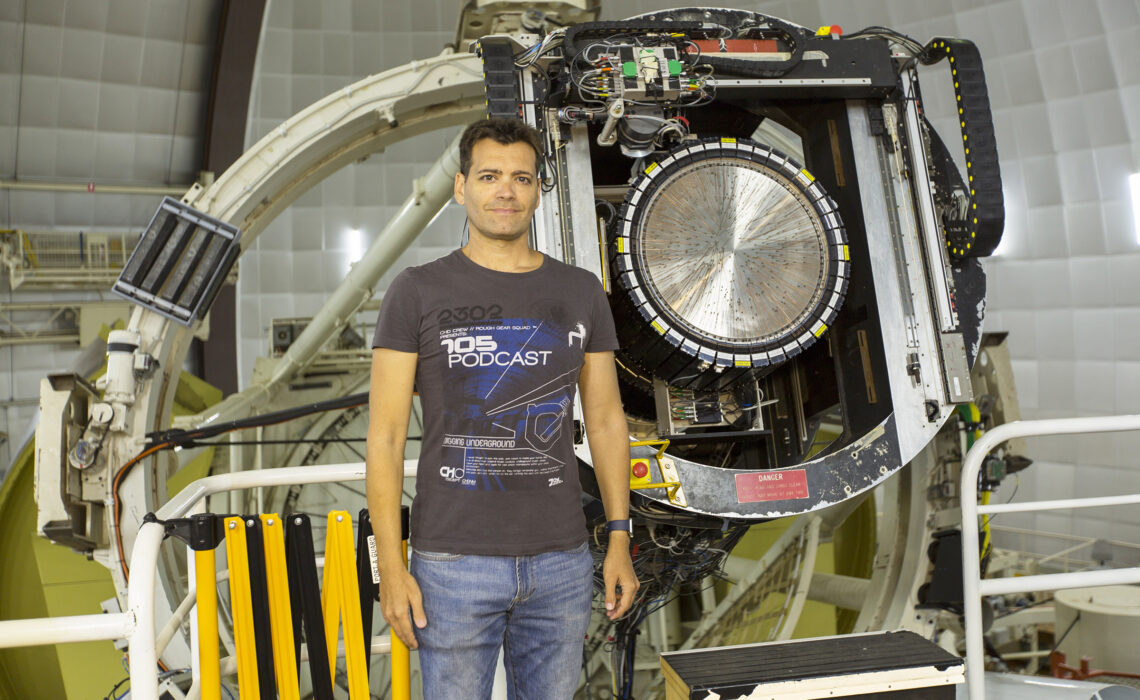
Credit: Ángel R. López-Sánchez (AAO-MQ)
Pink SuperMoon (or not)
Image of the (not) Pink (you won't see the difference) Super Moon obtained from our backyard in Sydney on Tuesday 27th April 2021, at 8:30pm local time.
This image combines 50 frames, 35ms each, obtained with a ZWO 1600MM-Pro at -20C, gain 100, using a ultra-narrow (3.5nm thick) H-alpha Baader filter.
The telescope used was a refractor Skywatcher Black Diamond 80mm, with a x0.75 focal reducer (effective focal length of 430mm) on a Skywatcher AZ-EQ6 Pro mount, everything controlled with the ZWO ASIAir.
The images (not corrected for darks or flatfield) were aligned and stacked using the Lynkeos software, also using the x2 Drizzle. The combined FITS image was then converted into TIF using Fits Liberator considering an Asinh scaling. Further adjustments with the contrast, shadows/highlights, and smart sharpening was performed in Photoshop.
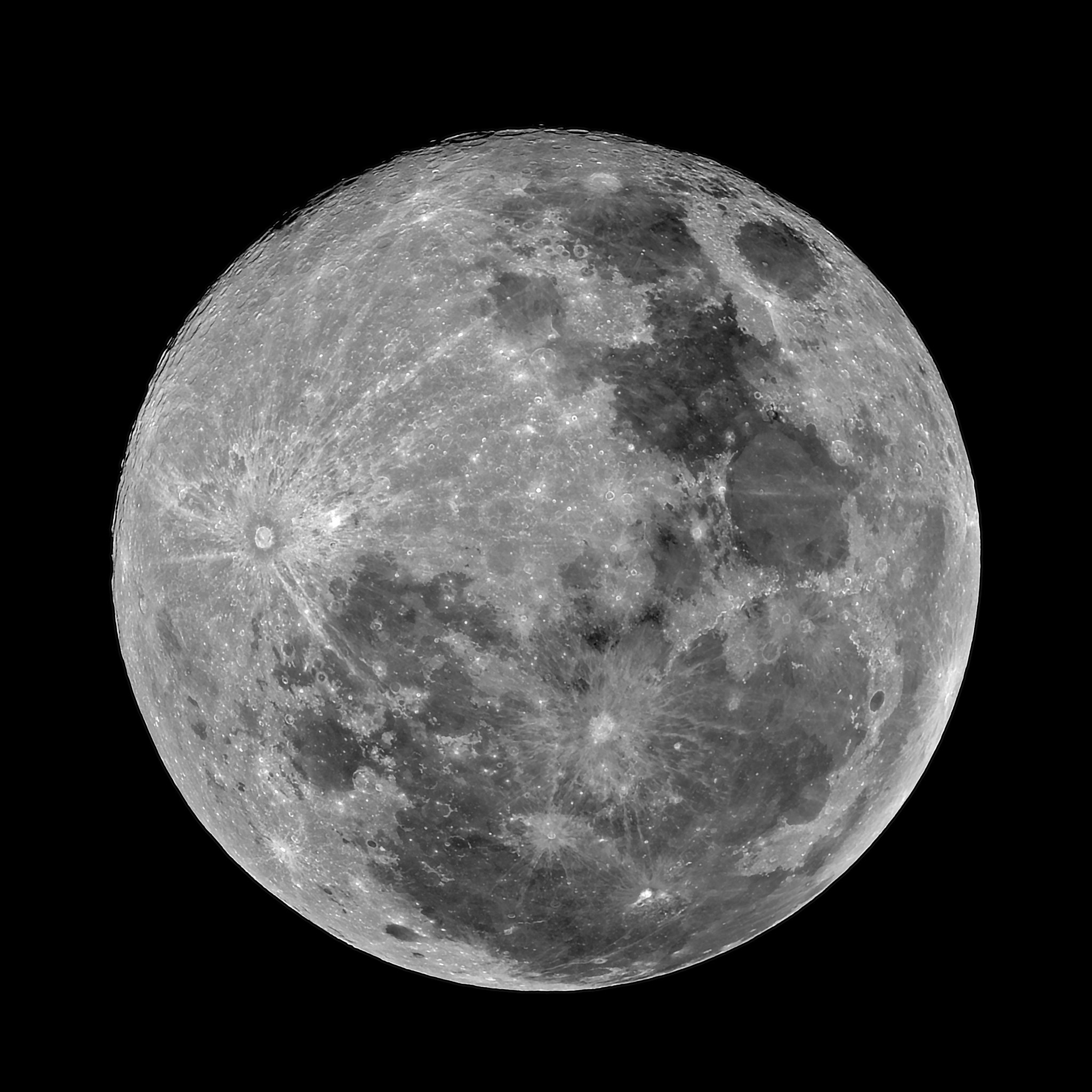
Credit of the image: Luke López-Planells (Ángels' 8 yr old son) and Ángel R. López-Sánchez (AAO-MQ).
The Trifid Nebula from Sydney
The Trifid Nebula, M 20, from my backyard, 15 km North from Sydney's city center, on 15th June 2020.
This image compiles 40 x 300s images (3.3 hours total integration time) obtained with my Skywatcher Black Diamond 80, an Orion X0.8 focal reducer (f/6), the ZWO ASI178MC camera and an OPTOLONG L-Pro filter.
I used the ZWO ASIAir to control the camera, the mount (Skywatcher AZ-EQ6) and the guiding system (ASI120MM + Orion 50mm finderscope).
Flats and darks included. Data processed with Siril software. Colour / saturation / levels / contrast / smart sharpen with Photoshop.
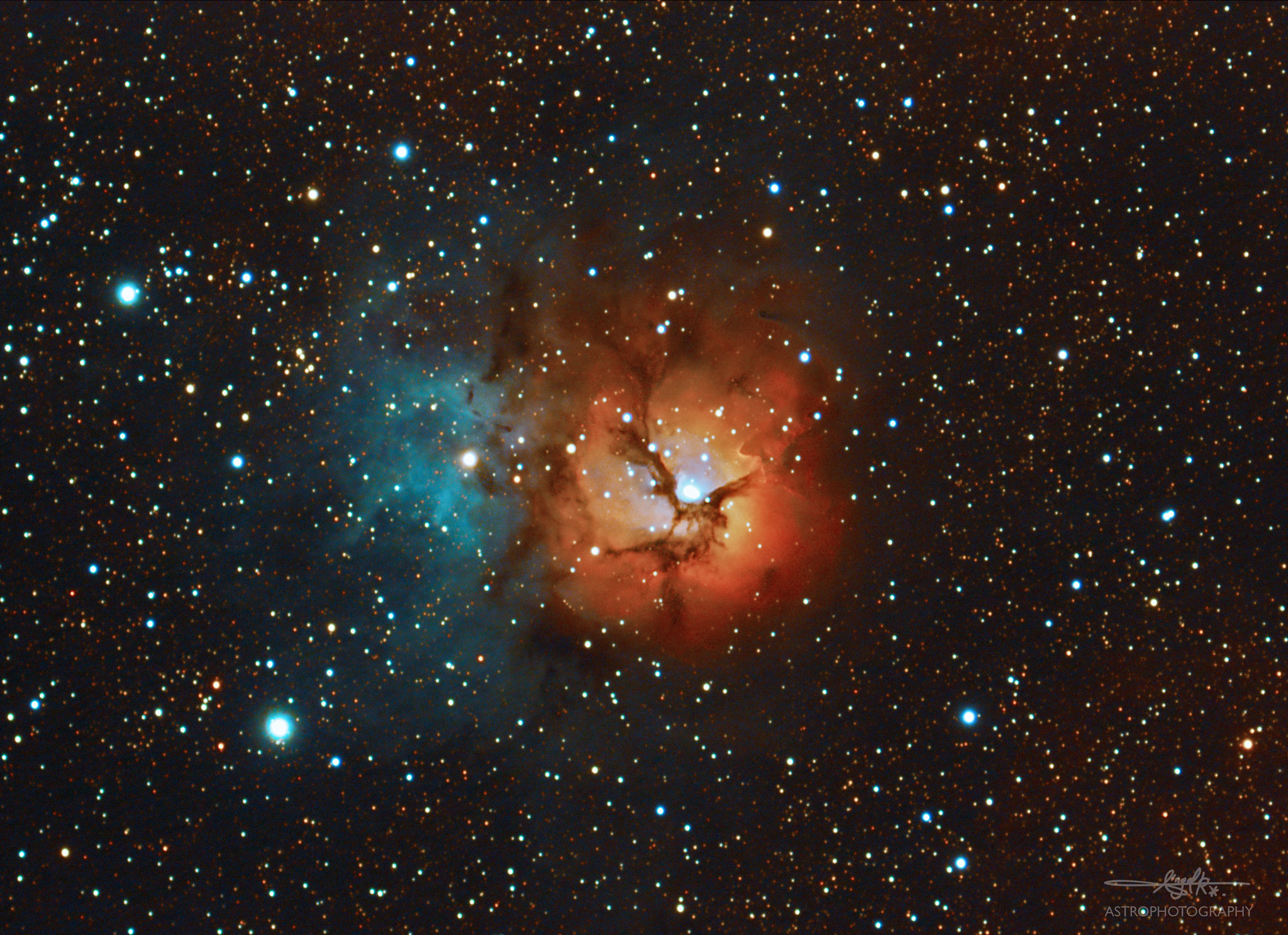
Credit: Ángel R. López-Sánchez (AAO-MQ).
Fire in the Cat's Paw Nebula
Deep H-alpha image of the Cat’s Paw Nebula (NGC 6334) in Scorpius obtained from my backyard, 15 km from Sydney’s city centre.
This image combines 40 frames I got during some few nights during September and early October 2020 (15, 16, 26, 28 Sep, 2, 3 Oct) using the ZWO ASI1600MM Pro and the H-alpha Baader 3.5nm ultra-narrow filter.
All frames had an exposition time of 900s (15 minutes), hence this image combines a total of 10 hours of telescope time!
Telescope: Skywatcher Black Diamond 80, f=600mm (f/7.5)
Equipment: I used the ZWO ASIAir to control the camera, the mount (Skywatcher AZ-EQ6) and the guiding system (ASI120MM + Orion 50mm finderscope). The H-alpha filter was in the ZWO filter drawer.
Processing: Data processed with Siril software. FITS converted on TIFF using NASA’s Fits Liberator considering a logarithmic function. Colour / saturation / levels / contrast / smart sharpen with Photoshop.
For this image I decided to give some false colour instead of just the greyscale image, I used Photoshop to get the kind of “fire” aspect to the gas in the nebulae.
I would love to get some data in broad-band filters to get the colours, but I’m afraid this will have to wait till next year, as Scorpius is already a bit too low over the western horizon, and some palm trees block the view from my backyard.
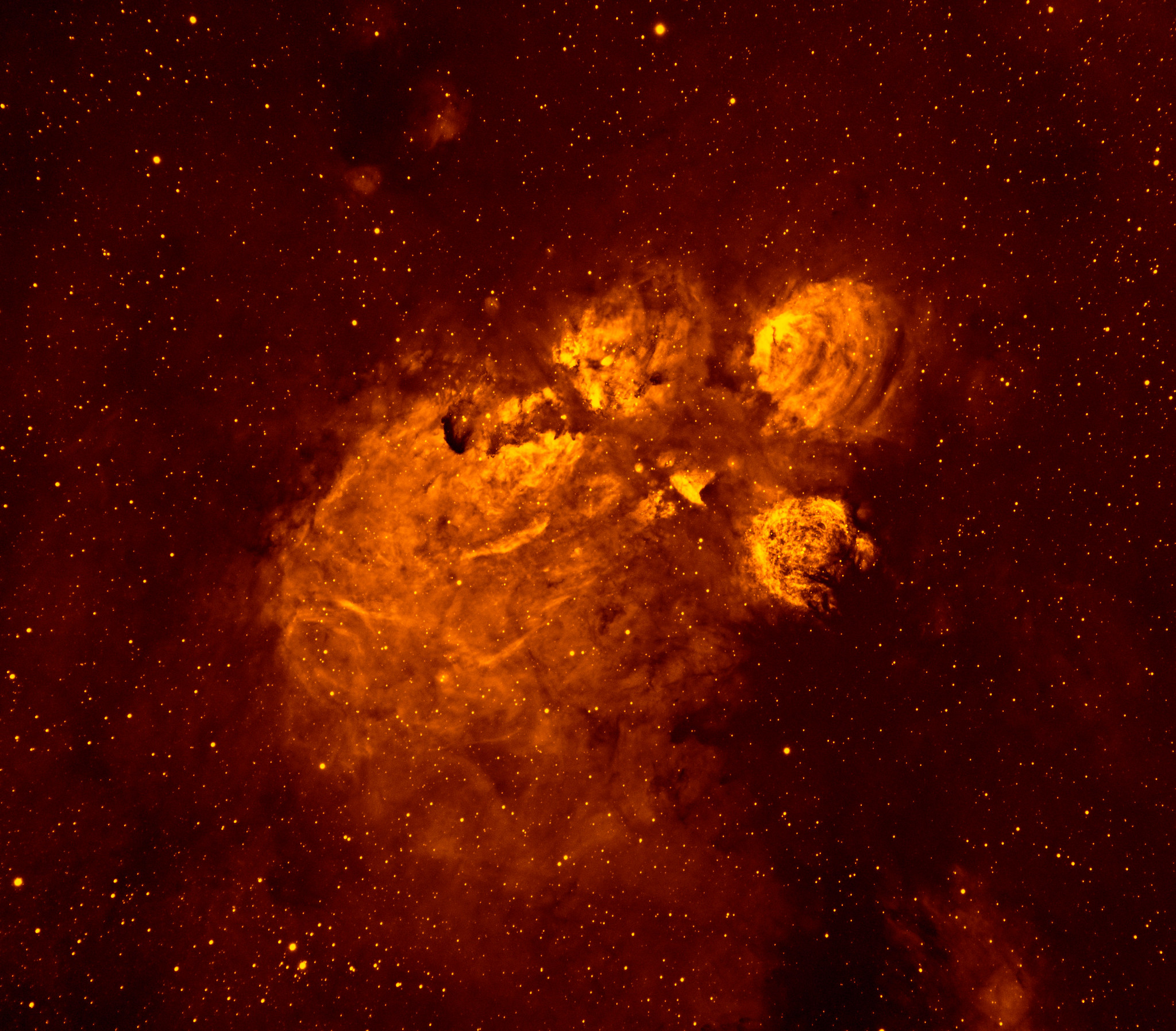
Credit: Ángel R. López-Sánchez (AAO-MQ).
My first H-alpha test of the Horsehead and Flame nebulae
H-alpha image of the Horsehead (left) and Flame (right) nebulae in Orion obtained from my backyard, 15 km from Sydney’s city centre.
This image combines 24 frames I got during some few nights in early October using the ZWO ASI1600MM Pro and the H-alpha Baader 3.5nm ultra-narrow filter.
All frames had an exposition time of 900s (15 minutes), hence this image combines a total of 6 hours of telescope time!
Telescope: Skywatcher Black Diamond 80, f=600mm (f/7.5)
Equipment: I used the ZWO ASIAir to control the camera, the mount (Skywatcher AZ-EQ6) and the guiding system (ASI120MM + Orion 50mm finderscope). The H-alpha filter was in the ZWO filter drawer.
Processing: Data processed with Siril software. FITS converted on TIFF using NASA’s Fits Liberator considering a logarithmic function. Colour / saturation / levels / contrast / smart sharpen with Photoshop.
For this image I decided to give some false colour instead of just the greyscale image, I used Photoshop to get the kind of “fire” aspect to the gas in the nebulae.
I was expecting to get more data to get the image deeper, unfortunately the weather, following "La Niña", is not cooperating in Eastern Australia in late 2020.
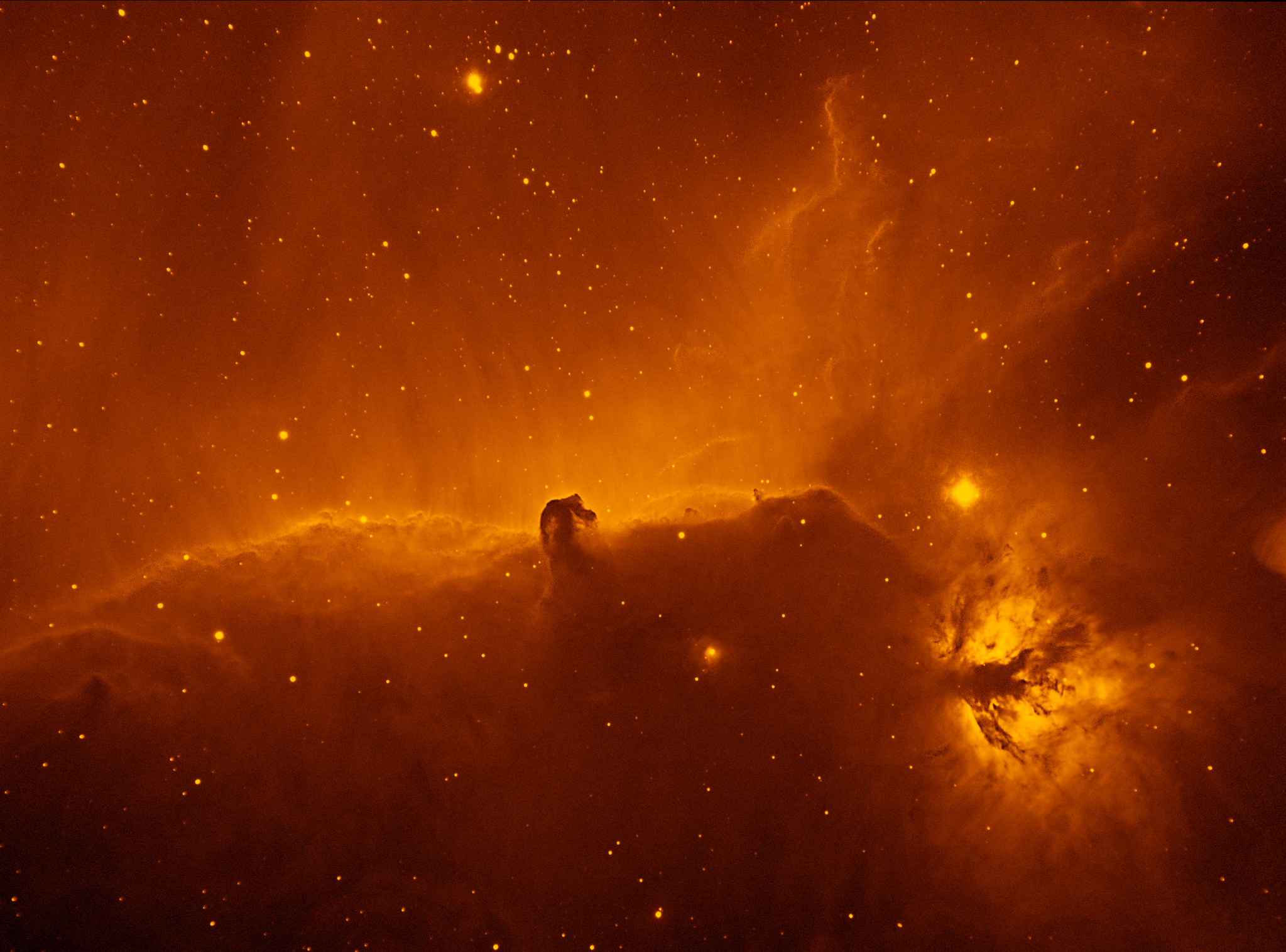
Credit: Ángel R. López-Sánchez (AAO-MQ).
Helix Nebula in H-alpha from Sydney
Deep H-alpha image of the Helix Nebula obtained from my backyard, 15 km from Sydney's city centre.
This image combines the best 40 frames of the 82 frames I got the nights of 24-30 August, 7, 12 and 15 September 2020 using the ZWO ASI1600MM Pro and the H-alpha Baader 3.5nm ultra-narrow filter.
All frames had an exposition time of 900s (15 minutes), hence this image combines a total of 10 hours of telescope time!
Telescope: Skywatcher Black Diamond 80, f=600mm (f/7.5)
Equipment: I used the ZWO ASIAir to control the camera, the mount (Skywatcher AZ-EQ6) and the guiding system (ASI120MM + Orion 50mm finderscope). The H-alpha filter was in the ZWO filter drawer.
Processing: Data processed with Siril software. FITS converted on TIFF using NASA's Fits Liberator considering a logarithmic function. Colour / saturation / levels / contrast / smart sharpen with Photoshop.
I hope to get soon some data in broad-band filters to get the colours!
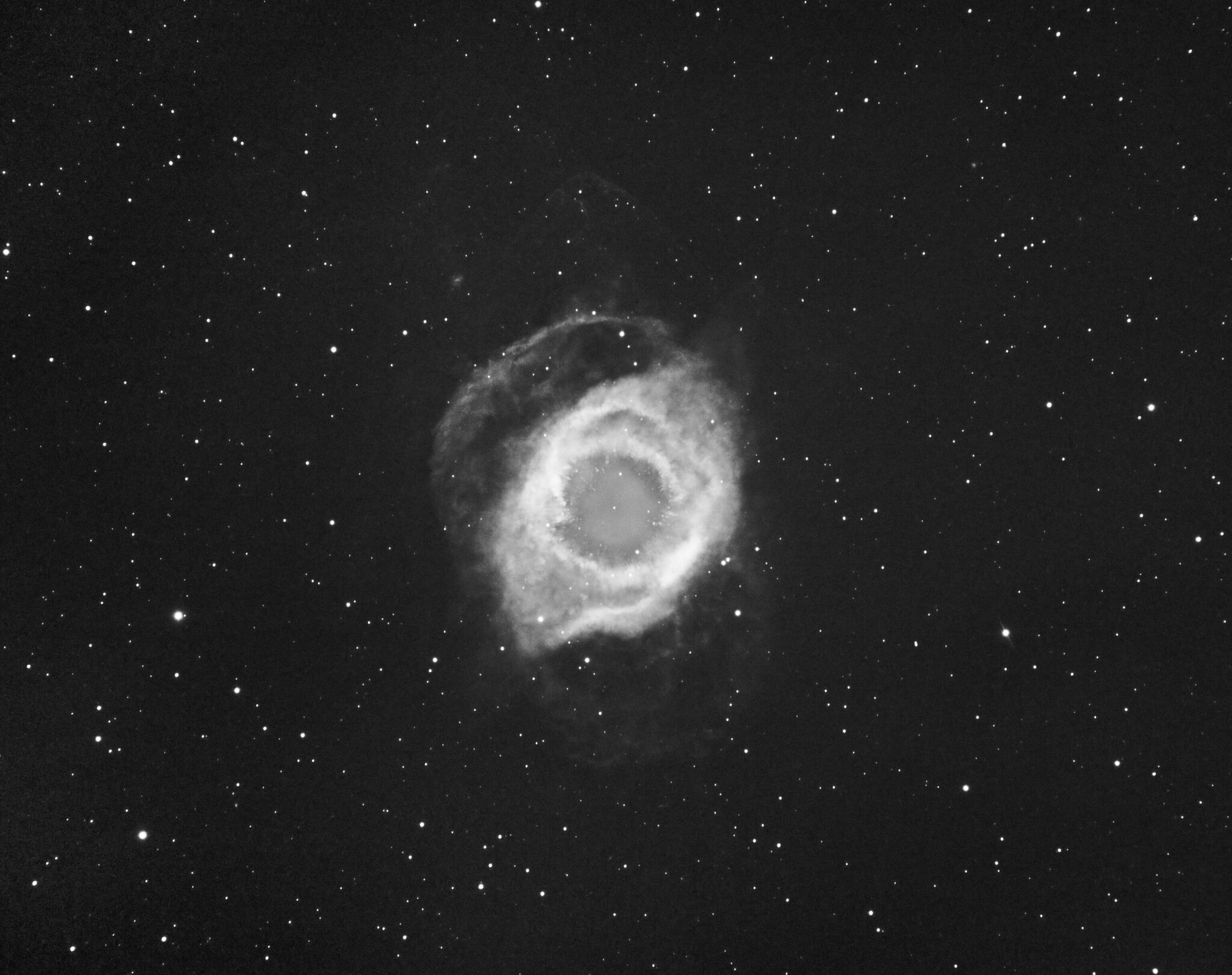
Credit: Ángel R. López-Sánchez (AAO-MQ).
Comet C/2020 F8 (SWAN) over Sydney
Comet C/2020 F8 (SWAN), Sydney, May the 4th, 2020, 5:15am
Image combining 10 x 2min exposures using an Optolong L-Pro filter, Skywatcher BD80, focal reducer Orion x0.8, ZWO ASI178MC. Mount Skywatcher AZ-EQ6 Pro mount, camera ZWO ASI120MM for guiding and ASIair for controlling everything.
Individual frames dark subtracted with Siril software, then I did the alignment on the comet manually in Photoshop (that is why stars are moved and blurry, as stacked with median), where I also played with the colour/brightness/contrast.
The top image is the resulting colour image, the bottom image is the greyscale image increasing the contrast to increase the visibility of the tail and the faintest features.
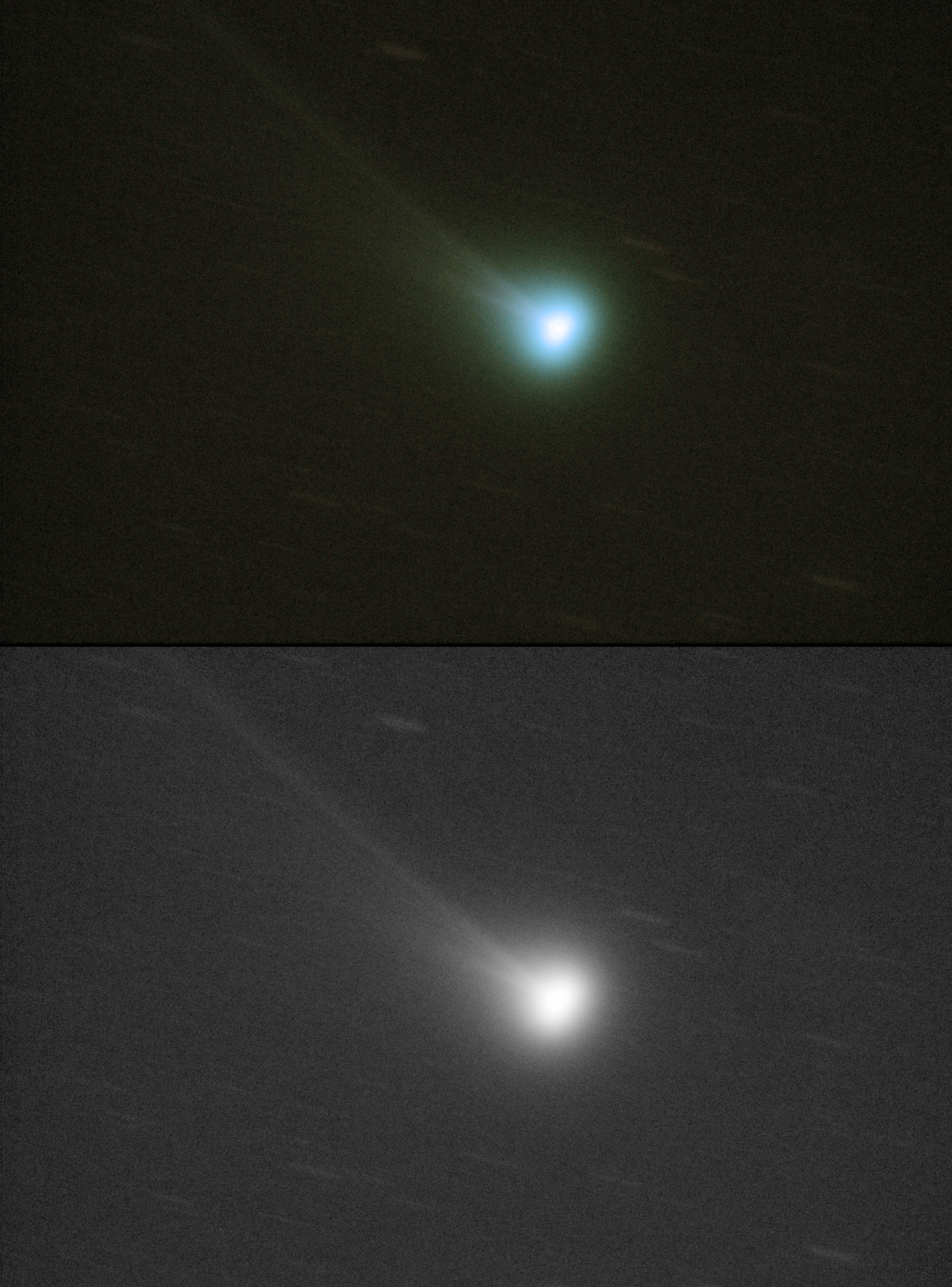
Credit: Ángel R. López-Sánchez (AAO-MQ).